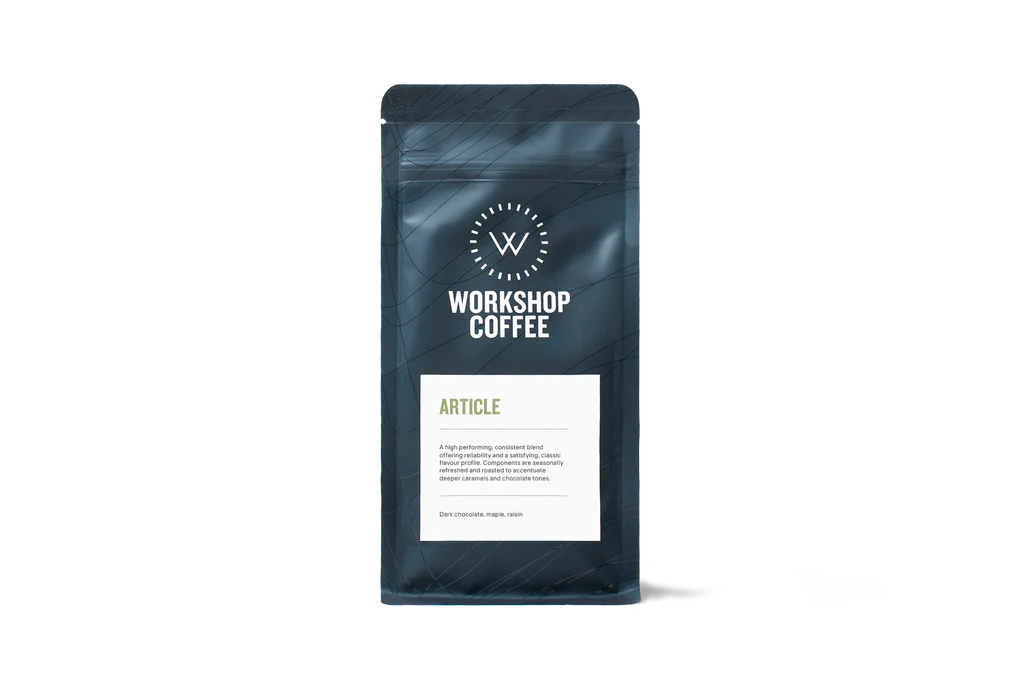Article - Filter & Espresso - 250g
Sold Out £10.00
RTICLE IS THE NAME OF OUR HOUSE COFFEE, A HIGH PERFORMING, CONSISTENT COFFEE BLEND OFFERING RELIABILITY AND A SATISFYING, CLASSIC FLAVOUR PROFILE. COMPONENTS ARE SEASONALLY REFRESHED AND ROASTED TO ACCENTUATE DEEPER CARAMELS AND CHOCOLATE TONES.
With each iteration we aim to compose a coffee that has great balance, packed with classic coffee characteristics whilst retaining a sweet, clean finish.
Current Composition:
Article Coffee 1 – Las Nubes, Nicaragua
Comprised of coffee from four dedicated families we are loving the clean fruit tones in this lot of Las Nubes from Dipilto, Nueva Segovia in Nicaragua. Several of these family members have placed in the Cup of Excellence coffee competition thanks to their commitment to producing high quality coffees.
The Producers
The families whose coffee has been combined to create this lot of Las Nubes are growing a combination of Caturra, Catuaí and Catimor amidst native forestry and tactically planted shade trees, such as Ingas (the ice cream bean tree) and various Musaceae (flowering trees like bananas). Their farms are located in Dipilto, Nueva Segovia and the Cordilla Isabelia mountain range, at altitudes range from 1,100 to 1,500 metres, and can range from a few hectares up to 25 hectares in size.
We find the cup profile to be somewhere between the more fruited coffees we buy from Jalapa in Nueva Segovia and the more chocolatey coffees we know and love from Jinotega.
Husband and wife, Guillermo Montenegro López and Rosa Marina López, along with their son Erling and his six siblings are based in Dipilto, and have all submitted parchment which contributed to this lot. They are all Cup of Excellence winners, stating the importance of the agronomical and technical support received on their coffee farms as invaluable.
Their neighbour Donald Roque López grows coffee on Finca San Ramon and is another CoE winner whose coffee makes up this iteration of Las Nubes. He tells how his whole family is involved in caring for the coffee trees with managing the right shade trees and organic fertiliser, as well as ensuring the harvest and processing are done with great attention to detail.
Their Approach:
Visiting La Concordia we were really impressed at the attention to detail taken in this oft-overlooked stage in the production chain. Coffees are dried on multi-tiered raised beds, under varying degrees of shade, using specially designed rakes. Hygrometers and thermometers are dotted around to ensure practices are amended and adapted to the climate, ensuring slow, uniform drying to preserve the coffees’ qualities for a long time.
Including this coffee as a component in our house blend, Article, contributes a sweet raisin-like flavour and adds to the syrupy mouthfeel. We find it also delivers accents of cacao nib and hints of red fruits.
Article Coffee 2 – Lepaterique, Honduras
We love coffees from Honduras, especially when they deliver that winning combination of flavours of chocolate, apple and brown sugar. This community lot from smallholders in the micro-region of Lepaterique delivers on this as well as representing a sustainable model whereby producers are supported with premium payments as well as training in agronomy and farm finances.
The Producers:
Lepaterique is a micro-region made up of a handful of small villages within the Francisco Morazán department, close to the border with Comayagua and La Paz departments. It translates to ‘Mountain of the Tiger’ in the local indigenous language, Lenca. The farmers here are tending to a combination of Catuaí and Bourbon, with Lempira being grown also, at altitudes between 1,200 and 1,450 metres.
As well as crop husbandry, harvesting protocols and post-harvest methodologies there is an importance placed on sustainability. Magdaleno García Martinez has converted part of their farm, Finca La Esperanza Verde, into a hiking trail and showcases best practices when it comes to agroforestry, waste management and treatment of processing waters, known locally as ‘aguamiel’.
Their Approach:
The infrastructures for processing and drying can be fairly rudimentary, but with the right starting blocks of good fruit selections and training in best post-harvest practices they can be very effective at producing high quality outturns. Coffee is grown amidst lush vegetation and under shade trees like bananas and guavas, which also act as secondary subsistence crops, whilst ground cover crops are left between the coffee plants, which can fix nitrogen, prevent erosion and promote biodiversity. After selectively picking the coffee cherries by hand they are received at the processing site, often in wooden hoppers, before being fed through manually cranked depulpers. We’ve seen ceramic tiled tanks for the fermentation stage, which is encouraging as it allows for more control and enables more thorough cleaning and consistency.
Coffee is the primary source of income for these farmers, subsidised with other food crops. The support received from Volcafe and their team of agronomists has had a direct positive impact on the quantity and quality of the coffee being produced, as well as enabling the growers to better understand their costs of production and run their farms with financial savvy. We are glad to be able to support such an initiative and are able to share the delicious results with yourselves.
The inclusion of Lepaterique in our Article blend contributes a maple syrup like complex sweetness and rounds out the body wonderfully. Through our roast approach we take what can be a crisp-apple acidity and soften the edges in the same way that cooking down apples makes them sweeter and more comforting.
Article Coffee 3 – Fazenda São Domingos, Brazil
This selective harvesting is usually done in two passes. In the first harvesting phase, the machines are adjusted to reach only the outermost point of the coffee plant, where the fruit normally ripens first. In the second pass, it is then adjusted to harvest the remaining fruit. Varieties are kept separate, with this lot being comprised of 100% Acaiá coffee.
At Fazenda São Domingos there is a total of about 9,000 M2 of drying terraces where the seeds are dried for between 10 and 15 days. They are then finished off in 8 dryers to achieve the ideal residual moisture. For storage, 8 wooden silos with a capacity of about 2,500 bags are available. In these silos, the coffee usually spends 4-6 weeks before it is later moved to a warehouse for dry-milling.
This component acts as a base note in our house blend, Article, delivering swathes of creamy chocolate and nougat. Think sticky caramel drenched stroopwaffels dipped into a malted chocolate milkshake.
© 2025 G!RO .

